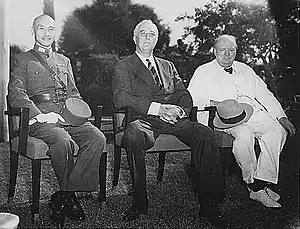1943 Cairo Declaration
The Cairo Declaration (Traditional Chinese: 《開羅宣言》) was the outcome of the Cairo Conference in Cairo, Egypt, on 27 November 1943. President Franklin Roosevelt of the United States, Prime Minister Winston Churchill of the United Kingdom, and Generalissimo Chiang Kai-shek of the Republic of China were present. The declaration developed ideas from the 1941 Atlantic Charter, which was issued by the Allies of World War II to set goals for the post-war order. The Cairo Communiqué was broadcast through radio on 1 December 1943.[1]

Text
"The several military missions have agreed upon future military operations against Japan. The Three Great Allies expressed their resolve to bring unrelenting pressure against their brutal enemies by sea, land, and air. This pressure is already rising."
"The Three Great Allies are fighting this war to restrain and punish the aggression of Japan. They covet no gain for themselves and have no thought of territorial expansion. It is their purpose that Japan shall be stripped of all the islands in the Pacific which she has seized or occupied since the beginning of the first World War in 1914, and that all the territories Japan has stolen from the Chinese, such as Manchuria, Formosa, and The Pescadores, shall be restored to the Republic of China. Japan will also be expelled from all other territories which she has taken by violence and greed. The aforesaid three great powers, mindful of the enslavement of the people of Korea, are determined that in due course Korea shall become free and independent."
"With these objects in view the three Allies, in harmony with those of the United Nations at war with Japan, will continue to persevere in the serious and prolonged operations necessary to procure the unconditional surrender of Japan."[2]
Impact
The Cairo Declaration is cited in Clause Eight (8) of the Potsdam Declaration, which is referred to by the Japanese Instrument of Surrender.
Both the People's Republic of China and the Republic of China cite the Cairo Declaration as one of the bases for the One-China Principle that Taiwan and Penghu are part of Republic of China.[3][4] The government of the U.S. considers the declaration a statement of intention and never formally implemented or executed.[5]
Controversy in Korean independence movement
Many prominent Koreans in the Korean independence movement, including Kim Gu and Syngman Rhee, were initially delighted by the declaration, but later noticed and became infuriated by the phrase "in due course". They took it to be an affirmation of Allied intent to place Korea into a trusteeship, rather than granting it immediate independence. There was significant concern that the trusteeship could be indefinite or last decades, making Korea functionally again a colony under a great power.[6][7]
The phrase "in due course" was not present in the first draft; it originally read "at the earliest possible moment after the downfall of Japan". The US suggested "at the proper moment", and finally the British "in due time". Exact motivations for these changes are unclear.[6]
See also
- Cairo Conference 1943
- Second Sino-Japanese War (1937–1945)
- Potsdam Declaration (July 1945)
- General Order No. 1 (August 1945)
- Japanese Instrument of Surrender (September 1945)
- Korea Retrocession (August 1945)
- Taiwan Retrocession (October 1945)
- Treaty of San Francisco (1951)
- Cairo Declaration (film)
References
- "Cairo Communiquè, December 1, 1943". Japan National Diet Library. December 1, 1943.
- Text of Cairo Declaration, Government of Japan website
- Zhao, Suisheng (2022). The Dragon Roars Back: Transformational Leaders and Dynamics of Chinese Foreign Policy. Stanford University Press. p. 34. doi:10.1515/9781503634152. ISBN 978-1-5036-3415-2.
- "MOFA reaffirms ROC sovereignty over Taiwan, Penghu". 5 September 2011.
- Monte R. Bullard (2008). Strait Talk: Avoiding a Nuclear War Between the US and China over Taiwan (PDF). Monterey, CA: James Martin Center for Nonproliferation Studies (CNS). p. 294. Archived from the original (PDF) on 2016-04-13.
- Caprio, Mark E. (2022). "(Mis)-Interpretations of the 1943 Cairo Conference: The Cairo Communiqué and Its Legacy among Koreans During and After World War II". International Journal of Korean History. 27 (1): 137–176. doi:10.22372/ijkh.2022.27.1.137. S2CID 247312286.
- "孫世一의 비교 評傳 (67) 한국 민족주의의 두 類型 - 李承晩과 金九". monthly.chosun.com (in Korean). 2007-10-07. Retrieved 2023-03-20.
External links
- Text of the Cairo Communiqué in the Japanese National Diet Library
- FRUS1943 Cairo Conference University of Wisconsin Digital Collection
- Cairo Declaration Department of State
- Cairo Declaration Yale University
- Cairo Formosa Declaration Out of Date, Says Churchill; CHURCHILL CALLS PLEDGE OUTDATED By Drew Middleton special To the New York Times. Feb. 2, 1955
- Cairo Formosa Declaration Out of Date, Says Churchill; CHURCHILL CALLS PLEDGE OUTDATED By Drew Middleton special To the New York Times. Feb. 2, 1955 (This source has a picture of the full newspaper article, including the continuation on page 4 of the original paper, which the nytimes.com source wouldn't show without membership)